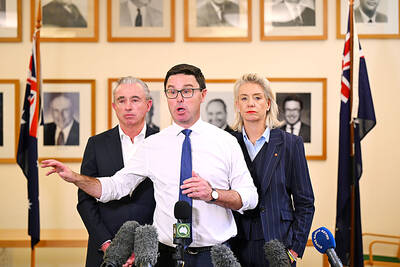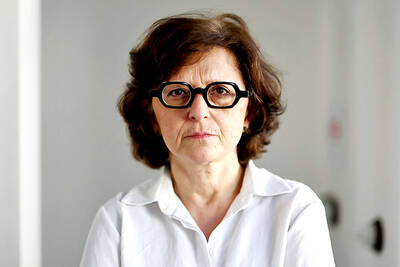Just before Japan announced its decision to buy an unproven US missile shield to defend itself against any future North Korean attack, the Australian government chose a much cheaper option.
It announced its decision to seek a research role in the multi-layered systems being developed by the US' Missile Defense Agency.
Although overshadowed by the later Japanese commitment to spend tens of billions of dollars to acquire a missile defense capability as soon as 2007, the Australian move adds to regional concerns that the program may spur a dangerous Asian arms race.
The Indonesian government said Australia's decision could destabilize the region and spark a regional contest to acquire increasingly sophisticated offensive and defensive systems.
"Australia should deal with its neighbors and not try to isolate itself from the region," the Indonesian foreign affairs spokesman, Marty Natelgawa, told Australian reporters.
"Our view has always been that research into such a system opens the potential for a new arms race. It could be potentially destabilizing," he said.
"As far as Indonesia is concerned, destabilization is not something that's inevitable, but from where we stand at the moment we see these things offering more uncertainties or complications than solutions."
The Chinese embassy in Canberra refused to comment on the Australian support for the missile defense system.
Its silence was a clear diplomatic signal of its displeasure and put the Australian foreign minister, Alexander Downer, on the defensive.
"The arms race argument is absurd," Downer said. "While China has never supported our position they increasingly understand that it isn't directed either at them, or the China-Taiwan issue.
"Australia is not being a US lackey as some of our critics claim. Our concern is the possibility of long range missiles being fired at Australia.
"We have to have some capacity to defend ourselves."
However, the analytical briefings being given in Canberra include some additional elements.
A comparison is being drawn between the economic stresses that US president Ronald Reagan's Star Wars program put on an already failing Soviet economy in its final years and the impact the "little" or baby Star Wars technology of the missile defense program might impose on the cash-starved regime of North Korean leader Kim Jong-il in Pyongyang.
Even though the Star Wars missile defense umbrella for the US was later declared a technological impossibility it is often argued to have been the most lethal mind game ever waged by one superpower against another.
The US ambassador in Australia, Thomas Schieffer, keeps comparing the two programs in his public comments.
"Star Wars was a strategic system designed to deter great powers like Russia and China. This system is directed only at rogue states.
"We hope that China and Russia will participate. We do not think it is a threat," he said.
Whether designed to bring down the North Korean economy, or any missiles it might fire at Japanese, the missile defense program seems likely to get conditional support from Mark Latham, the new leader of the Australian Labor Party.
In the few weeks that he has been opposition leader, Latham has put Labor into serious contention to beat the current conservative coalition government of Prime Minister John Howard in the general election, which must be held sometime next year.
While Latham has refused to give immediate endorsement to an Australian role in the US program pending future discussions, party sources say he favours participation because it would give the country a seat at the table when crucial decisions were being made.
Apart from that, Latham has pledged to maintain defense ties with the US despite calling US President George W Bush "the most dangerous US president in history."
Canberra defense analyst Geoffrey Barker said the missile defense system was technically speculative and strategically momentous.
"It is especially likely to have repercussions in our region, where China, our most important emerging trading partner, is deeply skeptical.
"It overturns three decades of thinking on nuclear containment based on the deterrent of mutually assured destruction and the Anti-Ballistic Missile Treaty. It also promises to be prohibitively costly, with a down payment of $50 billion over the next five years, though Australia's contribution will be small."
And the doubts keep mounting up, like the costs. In September the US General Accounting Office noted that only two of ten technologies vital to the success of the missile shield are proven.
The American Physical Society, representing eminent physicists and engineers linked to the defense establishment, had declared that a crucial part of the missile shield -- stopping a missile during the rocket boost phase -- might never work.
However, defense sources in Canberra say the initial system looks promising, being based on Aegis class destroyers firing SM-3 interceptor rockets toward rising hostile missiles, and ground-based Patriot Advanced Capability-3 missiles mopping up those that made it closer to their targets.
Unfortunately, promising doesn't mean foolproof or terrorist-proof.
None of the analysts briefing the Australian media could explain how the missile defense system would stop the personal delivery of a nuclear or biological weapon via a briefcase.

BACKLASH: The National Party quit its decades-long partnership with the Liberal Party after their election loss to center-left Labor, which won a historic third term Australia’s National Party has split from its conservative coalition partner of more than 60 years, the Liberal Party, citing policy differences over renewable energy and after a resounding loss at a national election this month. “Its time to have a break,” Nationals leader David Littleproud told reporters yesterday. The split shows the pressure on Australia’s conservative parties after Prime Minister Anthony Albanese’s center-left Labor party won a historic second term in the May 3 election, powered by a voter backlash against US President Donald Trump’s policies. Under the long-standing partnership in state and federal politics, the Liberal and National coalition had shared power

CONTROVERSY: During the performance of Israel’s entrant Yuval Raphael’s song ‘New Day Will Rise,’ loud whistles were heard and two people tried to get on stage Austria’s JJ yesterday won the Eurovision Song Contest, with his operatic song Wasted Love triumphing at the world’s biggest live music television event. After votes from national juries around Europe and viewers from across the continent and beyond, JJ gave Austria its first victory since bearded drag performer Conchita Wurst’s 2014 triumph. After the nail-biting drama as the votes were revealed running into yesterday morning, Austria finished with 436 points, ahead of Israel — whose participation drew protests — on 357 and Estonia on 356. “Thank you to you, Europe, for making my dreams come true,” 24-year-old countertenor JJ, whose

A documentary whose main subject, 25-year-old photojournalist Fatima Hassouna, was killed in an Israeli airstrike in Gaza weeks before it premiered at Cannes stunned viewers into silence at the festival on Thursday. As the cinema lights came back on, filmmaker Sepideh Farsi held up an image of the young Palestinian woman killed with younger siblings on April 16, and encouraged the audience to stand up and clap to pay tribute. “To kill a child, to kill a photographer is unacceptable,” Farsi said. “There are still children to save. It must be done fast,” the exiled Iranian filmmaker added. With Israel

Africa has established the continent’s first space agency to boost Earth observation and data sharing at a time when a more hostile global context is limiting the availability of climate and weather information. The African Space Agency opened its doors last month under the umbrella of the African Union and is headquartered in Cairo. The new organization, which is still being set up and hiring people in key positions, is to coordinate existing national space programs. It aims to improve the continent’s space infrastructure by launching satellites, setting up weather stations and making sure data can be shared across